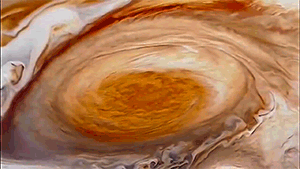




목성에는 남반구에 대적반이 있는 걸로 유명하다. 최초로 대적반을 발견했던 당시엔 목성의 거대분지라고 생각했었다. 그리고 보이저 2호 덕분에 이것은 거대 소용돌이 구조임을 알게 되었다. 대적반의 소용돌이 속도는 시속 500km 이상이다. 쉽게 말하면 태풍이다.
참고로 근래 들어 옆에 소적반이 생겨 NASA에 충격을 줬다. 이 대적반은 지구 3개가 들어갈 정도로 크다. 카시니가 1665년에 발견한 이후 약 300년간 지속되고 있는데(발견 시점에서 그렇다는 거지 실제론 더 길 확률이 높다), 이는 목성이 가진 에너지가 무지막지한 데다가 폭풍을 약화시켜줄 암석표면이 없기 때문이다.
2014년 5월 23일 워싱턴포스트지에 따르면 이 대적반의 크기가 줄어들고 있는 것으로 관측되었다고 한다. 이유는 불명.# 그럼에도 2014년 5월 현재 지름이 약 16,495km에 달하여 여전히 지구(적도 기준 지름 약 12756km)보다는 여전히 크다. 하지만 19세기 후반까지만 하더라도 지름이 41,038km에 달했다는 점을 고려하면 우주적 시간 개념에서는 확실히 급속한 축소라고 볼 만하다. 다만 실제로 대적반이 죽는다기보단 작은 폭풍들이 합쳐지고 쪼개지는 과정에서 생기는 것이란 견해도 있다.#
2014년 NASA의 전문가들은 목성 대기 상층부에 있는 암모니아와 아세틸렌 가스가 태양 자외선의 영향을 받아 붉은 물질을 내놓는데, 대적반의 소용돌이 폭풍이 이것의 확산을 막으면서 대적반 부근만 연한 붉은 색을 띠게 되는 것이라는 결론을 내렸다. 이전에는 대적반의 원인이 목성 심층부의 화학물질이라는 이론이 주류였으나 이번에 반전된 것이며 또한 목성 하면 바로 떠올리는 것으로 상단의 그림처럼 표면의 독특한 줄무늬다. 이 줄무늬는 변화무쌍한 목성의 기류로 인해 생기는 것이라고 이야기를 하지만 사실 구체적인 메카니즘은 아직까지 모른다. 목성 특유의 줄무늬는 중저가의 천체망원경으로도 관측을 할 수는 있는데, 굵직한 것 몇 줄만 보일 뿐이니 혹시 관측해볼 생각이 있는 사람은 크게 기대하지 않는 것이 좋다. 더불어 변화무쌍하다는 표현 그대로 줄무늬의 모습이 변하거나 혹은 사라졌다가 다시 나타나기를 반복하는데, 2010년 5월 아마추어 천문가가 촬영한 사진에서 남반구의 줄무늬가 사라져서 화제가 되었다. 사실 이 현상은 10여 년에 한 번씩 있는 일이라고 한다.
대적반뿐만 아니라 작은 소용돌이 흐름들도 상당히 많이 관측되는데(작다고는 해도 지구 전체를 덮을 정도로 큰 것들이 많다.) 이렇게 강력한 소용돌이 흐름들이 계속 유지되는 이유는 목성의 엄청나게 빠른 자전 속도 때문. 목성은 지구보다 훨씬 크지만 자전 주기는 10시간에 불과하다.
Jupiter is famous for having the Great Red Spot in its southern hemisphere. When the Great Red Spot was first discovered, it was thought to be a giant basin of Jupiter. And thanks to Voyager 2, it was discovered that this is a giant vortex structure. The vortex speed of the Great Red Spot is more than 500 km/h. Simply put, it is a typhoon.
For reference, a small red spot has recently appeared next to it, shocking NASA. The Great Red Spot is so large that 3 Earths fit inside it. It has lasted about 300 years since Cassini's discovery in 1665 (at the time of discovery, but likely longer), because Jupiter's tremendous energy and lack of a rocky surface to dampen its storms.
According to the Washington Post on May 23, 2014, it was observed that the size of the Great Red Spot is shrinking. The reason is unknown.# Nevertheless, as of May 2014, its diameter reached about 16,495 km, so it is still larger than Earth (about 12756 km at the equator). However, considering that the diameter reached 41,038 km even by the late 19th century, it is certainly a rapid shrinkage in terms of cosmic time. However, there is also a view that the Great Red Spot does not actually die, but rather is created in the process of merging and splitting small storms.#
In 2014, NASA experts said that ammonia and acetylene gas in the upper atmosphere of Jupiter are affected by solar ultraviolet rays and release red substances. concluded. In the past, the theory that the cause of the Great Red Spot was a chemical substance in the depths of Jupiter was the mainstream, but this time it was reversed, and it is also a unique stripe on the surface that immediately comes to mind when you think of Jupiter, as shown in the picture above. It is said that these stripes are caused by Jupiter's ever-changing air currents, but in fact, the specific mechanism is still unknown. Jupiter's distinctive stripes can be observed with a mid-priced astronomical telescope, but only a few bold lines are visible, so it is better not to expect too much if you are thinking of observing them. In addition, the shape of the stripes changes or disappears and then reappears, just as the expression is ever-changing. In fact, it is said that this phenomenon happens once every 10 years or so.
Not only the Great Red Spot, but also a lot of small vortex flows are observed (even if they are small, there are many that are large enough to cover the entire earth). Although Jupiter is much larger than Earth, its rotation period is only 10 hours.
'현상 > 기상학' 카테고리의 다른 글
| 회오리구름 슈퍼셀 Supercell Twister Whirlwind (0) | 2023.04.12 |
|---|---|
| 해왕성의 대암점 Great Dark Spot of Neptune (0) | 2023.04.10 |
| 지구의 태풍 Hurricane of Earth (0) | 2023.04.08 |
| 무지개구름 채운彩雲 Iridescent cloud 환수평호(環水平弧·Circumhorizontal arc) Circle Rainbow (0) | 2023.01.06 |
| 푸른 분출번개 Blue Jet 블루 제트 (0) | 2023.01.05 |
